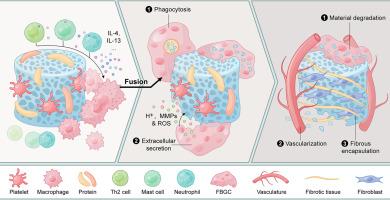Formation and biological activities of foreign body giant cells in response to biomaterials
IF 9.4
1区 医学
Q1 ENGINEERING, BIOMEDICAL
引用次数: 0
Abstract
The integration of biomaterials in medical applications triggers the foreign body response (FBR), a multi-stage immune reaction characterized by the formation of foreign body giant cells (FBGCs). Originating from the fusion of monocyte/macrophage lineage cells, FBGCs are pivotal participants during tissue-material interactions. This review provides an in-depth examination of the molecular processes during FBGC formation, highlighting signaling pathways and fusion mediators in response to both exogenous and endogenous stimuli. Moreover, a wide range of material-specific characteristics, such as surface chemical and physical properties, has been proven to influence the fusion of macrophages into FBGCs. Multifaceted biological activities of FBGCs are also explored, with emphasis on their phagocytic capabilities and extracellular secretory functions, which profoundly affect the vascularization, degradation, and encapsulation of the biomaterials. This review further elucidates the heterogeneity of FBGCs and their diverse roles during FBR, as demonstrated by their distinct behaviors in response to different materials. By presenting a comprehensive understanding of FBGCs, this review intends to provide strategies and insights into optimizing biocompatibility and the therapeutic potential of biomaterials for enhanced stability and efficacy in clinical applications.
Statement of significance
As a hallmark of the foreign body response (FBR), foreign body giant cells (FBGCs) significantly impact the success of implantable biomaterials, potentially leading to complications such as chronic inflammation, fibrosis, and device failure. Understanding the role of FBGCs and modulating their responses are vital for successful material applications. This review provides a comprehensive overview of the molecules and signaling pathways guiding macrophage fusion into FBGCs. By elucidating the physical and chemical properties of materials inducing distinct levels of FBGCs, potential strategies of materials in modulating FBGC formation are investigated. Additionally, the biological activities of FBGCs and their heterogeneity in responses to different material categories in vivo are highlighted in this review, offering crucial insights for improving the biocompatibility and efficacy of biomaterials.

异物巨细胞对生物材料的形成和生物活性。
生物材料在医疗应用中的整合会引发异物反应(FBR),这是一种以异物巨细胞(FBGCs)的形成为特征的多阶段免疫反应。FBGCs 起源于单核细胞/巨噬细胞系细胞的融合,是组织与材料相互作用过程中的关键参与者。本综述深入探讨了 FBGC 形成过程中的分子过程,重点介绍了信号传导途径和融合介质对外源性和内源性刺激的反应。此外,各种材料的特定特性,如表面化学和物理特性,已被证明会影响巨噬细胞与 FBGC 的融合。本综述还探讨了 FBGCs 的多方面生物活性,重点是它们的吞噬能力和细胞外分泌功能,这些功能对生物材料的血管化、降解和封装有着深远的影响。本综述进一步阐明了 FBGCs 的异质性及其在 FBR 过程中的不同作用,它们对不同材料的不同反应行为也证明了这一点。通过对 FBGCs 的全面了解,本综述旨在为优化生物材料的生物相容性和治疗潜力提供策略和见解,以提高临床应用的稳定性和有效性。意义声明:作为异物反应(FBR)的一个标志,异物巨细胞(FBGCs)对植入式生物材料的成功与否有很大影响,可能导致慢性炎症、纤维化和设备故障等并发症。了解异物巨细胞的作用并调节其反应对材料的成功应用至关重要。本综述全面概述了引导巨噬细胞融合成 FBGCs 的分子和信号通路。通过阐明诱导不同水平 FBGCs 的材料的物理和化学特性,研究了材料调节 FBGC 形成的潜在策略。此外,本综述还强调了 FBGCs 的生物活性及其在体内对不同类别材料反应的异质性,为改善生物材料的生物相容性和功效提供了重要见解。
本文章由计算机程序翻译,如有差异,请以英文原文为准。
求助全文
约1分钟内获得全文
求助全文
来源期刊

Acta Biomaterialia
工程技术-材料科学:生物材料
CiteScore
16.80
自引率
3.10%
发文量
776
审稿时长
30 days
期刊介绍:
Acta Biomaterialia is a monthly peer-reviewed scientific journal published by Elsevier. The journal was established in January 2005. The editor-in-chief is W.R. Wagner (University of Pittsburgh). The journal covers research in biomaterials science, including the interrelationship of biomaterial structure and function from macroscale to nanoscale. Topical coverage includes biomedical and biocompatible materials.
 求助内容:
求助内容: 应助结果提醒方式:
应助结果提醒方式:


